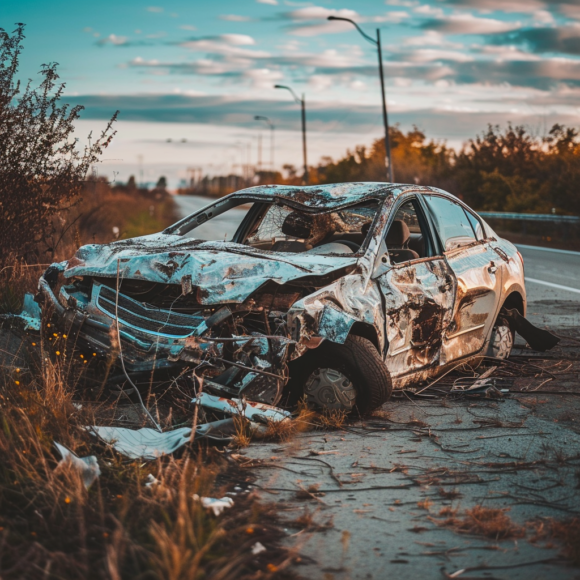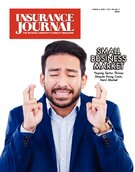The auto insurance market is tough and varied. Totaled auto losses are up, down or relatively stable, depending on the data source.
Ever since the personal auto segment recorded a combined ratio of 112 in 2022 – a figure not seen since the mid-1970s – the property/casualty line has endured increased scrutiny. In response, auto insurers tightened their risk appetites and raised rates to compensate for costlier parts and longer repair times, the result of tech-laden vehicles.
With the goal of reducing loss costs and expenses, one area of focus within the claims process is total loss frequency, a figure that represents vehicles considered unrepairable. Because artificial intelligence-backed tools are increasingly being used by insurers, particularly photo-based AI applications to estimate damage to autos that result from accidents, it’s natural to wonder whether the use of AI tools is contributing to an increase in the number of totaled vehicles.
While it may be easy to point to a rise in total loss evaluations on the expanding use of AI-backed photo damage estimating tools by auto insurers, there are many other factors at play, experts contacted for this article say. A major factor making it difficult to pin down total loss figures has to do with vehicle values.
There is no doubt that AI-powered visual assessment has increased efficiency in the auto damage estimating process. It is a tool that can assess value based on make and model, the damage sustained, and the cost for parts and labor to repair the vehicle, offering insurers the ability to appraise many more vehicles in one day than ever before.
Within the North American market, James Spears, head of Automotive-Artificial Intelligence for Tractable.AI, said the primary use case is not writing an appraisal. Instead, it is integrating AI within the estimating process, typically for auto insurers with direct repair programs. Estimates and photos are submitted by auto body shops to the insurer for review. Within seconds, AI assesses the damage and reviews the estimates, expediting the appraisal process.
“So, what you now have is a very integrated process where a shop is able to write an appraisal, they submit it, AI looks at it, approves it, gets back to them within seconds and says, ‘Let’s start the job,'” Spears explained. Through the vehicle identification number and the photos of the damage provided to it, AI can evaluate the cost to repair versus replace a car.
The process reduces cycle time significantly, reduces or eliminates costs associated with a policyholder or claimant renting a car, reduces or eliminates towing and storage fees, and leads to greater customer satisfaction, said both Spears and Karin Bogenschneider, assistant vice president, Claims Division, for Wisconsin-based West Bend Mutual Insurance.
Spears said in his prior job running USAA’s Auto Physical Damage Team, the number one decision was how to accurately assess whether a vehicle was repairable or not.
Kyle Krumlauf, director of industry analytics for CCC Intelligent Solutions, reported that total losses had been elevated during most of the pandemic and are trending up again. Although the use of AI and photo estimating by auto insurers has increased significantly, too, Krumlauf does not see any correlation between an increase in photo-based AI estimating and total losses.
“Our data suggests total loss increases are a result of several factors, including a decrease in used vehicle prices and an aging vehicle population,” he said.
CCC data indicated the percentage of estimates initiated by photos through 2022 was nearly 30% versus pre-pandemic (fourth-quarter 2019), when photo-initiated estimates were about 16%. According to Krumlauf, adoption of photo-based AI estimating accelerated because of shelter-in-place measures during the pandemic.
“The industry began embracing more digital technologies in order to continue to serve policyholders and drivers,” he added. “Growth and adoption of AI for estimating and other key decisions has continued based on CCC data.”
CCC data also showed that 82% of consumers that used a digital experience to manage their claims would do so again.
Experts agree consumers want to be part of the claims process to gain a better understanding of how repair or replacement decisions are made.
Bogenschneider said West Bend Mutual Insurance has an estimated 75% acceptance rate in terms of those willing to move forward using the AI-tool.
According to Spears, vehicles are on the road longer, something that can be attributed to longer loan periods. Instead of 36-month terms, it is not uncommon to see vehicles with loan terms of 72-84 months. This equates to more older vehicles remaining in the insurance pool because they must have collision and comprehensive coverage during the loan’s life.
“There’s a much higher correlation – if you’re looking for something – of length of loan to being in the insurance pool that leads to the fact that you have an insured total loss,” Spears said.
Olivier Baudoux, senior vice president of Global Product Strategy and AI for Mitchell’s Auto Physical Damage division, seconded the notion that AI photo estimating is not driving more total losses. Instead, he cited soaring new vehicles prices as a factor.
“The decision of repairing a vehicle or deciding to total and replace a vehicle has changed really significantly with the price of … new vehicles going up,” said Baudoux.
In fact, reviewing the frequency of vehicles being declared a total loss from first-quarter 2019 through third-quarter 2023, along with the average market value of those vehicles, Mitchell found that total loss frequency has decreased in the U.S. –to 18.0% in third-quarter 2023 from 20.7% in fourth-quarter 2022. (Editor’s Note: Looking at a different time frame, LexisNexis Risk Solutions pointed to an uptick in total losses in its 2023 U.S. Auto Insurance Trends Report. The firm said its most recent internal data indicated that 27% of collision claims for the first nine months of 2022 were total losses, up from 24% for full-year 2021, attributing the rise to increased auto accident severity.)
Baudoux said AI essentially mimics what a good appraiser would do.
Bogenschneider agreed that factors other than AI use are at play in total loss determinations.
“Total losses are up because of vehicle complexity,” she said. “It’s more expensive to fix a car. Parts are more expensive than ever before. They have thousands upon thousands of microchips inside of them, and all of that costs more money. And so that’s why total losses are up.”
Deeming a vehicle a total loss is not necessarily beneficial to the insurer. “From a carrier perspective, it’s so much easier, so much better for the consumer to fix your car, have a great experience doing it and retain the customer,” Spears said. “The moment that a vehicle [is deemed] a total loss, two things happen. The consumer goes shopping for a new car. And at the same time, they generally now shop for a new insurance carrier.”
The Future of AI and Vehicle Damage Estimating
Though most insurers choose to have adjusters or appraisers review AI-generated photo estimates, Baudoux said that each carrier can assess how they want to proceed – straight-through processing and potentially settling on payment, or whether they want to put some more work toward editing and reviewing an estimate.
West Bend Mutual Insurance reviews AI photo estimates 100% of the time, Bogenschneider said.
The Wisconsin-based insurer partnered with CCC Intelligence to utilize its AI photo damage estimating tool in early 2020, prior to the pandemic, offering it as an option to policyholders and claimants.
The value of the tool became clear to the company after a significant derecho impacted several policyholders. High winds caused trees and power lines to go down, damaging vehicles. The extreme weather event highlighted the danger to policyholders and claims staff, as well as the usefulness of the AI-powered tool.
It is the work done behind the scenes that makes AI-photo estimating invaluable, according to Bogenschneider.
Heat-mapping identifies damage through photos submitted by a policyholder or claimant. The photos typically include the four corners of a vehicle and the vehicle identification number.
“Behind the scenes it’s creating a build sheet – what the estimate is based on,” said Bogenschneider.
“Early on, [the estimate] would go to an appraiser to finish and then to a claims adjuster for review and payment. Now the AI tool, based off what it sees, knows to prompt the customer to take more photos,” she explained.
Through the photos submitted, the AI tool might determine the damage is severe enough to warrant a total loss designation.
“What AI provides is an extra accuracy in trying to create more consistency in how estimates are being written, removing a little bit of the human judgment and then creating an estimate in a state that would be consistent with how the machine has been trained,” Baudoux explained.
He added that the machine’s training generally comes “from best practices of how the industry has written millions of estimates over the last few years.”
Mitchell has been working on improving AI for the past six years to automate the creation of an estimate, called straight-through processing, so data can pre-populate the entirety of the estimate to the point where there will not be a need for human intervention.
Baudoux said that each carrier can assess how they want to proceed toward straight-through processing, indicating it is the future.
He expects the use of AI photo estimating in auto physical damage claims to increase in the future, with auto insurers allowing AI to make decisions as they reduce oversight.
“What’s most important is to appreciate the fact that the volume of estimates that will be a candidate for straight-through processing where there’s no human intervention whatsoever will dramatically go up over the next few years,” he said.
Topics Trends Auto Profit Loss
Was this article valuable?
Here are more articles you may enjoy.



 Is the AI Boom a Bubble Waiting to Pop? Here’s What History Says
Is the AI Boom a Bubble Waiting to Pop? Here’s What History Says  Good Times for US P/C Insurers May Not Last; Auto Challenges Ahead
Good Times for US P/C Insurers May Not Last; Auto Challenges Ahead  High-Net-Worth Risk Appetite Drops as Some Regions Show Stabilization
High-Net-Worth Risk Appetite Drops as Some Regions Show Stabilization  ’60 Minutes’ Homeowners Ask Court to Force DFS to Divulge Heritage Probe Info
’60 Minutes’ Homeowners Ask Court to Force DFS to Divulge Heritage Probe Info 


